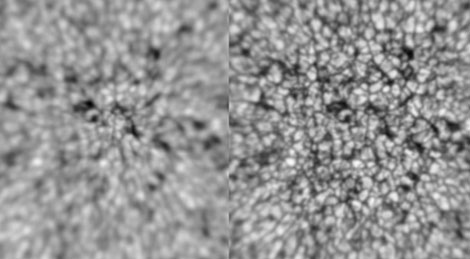Conventional (left) and multi-conjugate (right) solar adaptive optics (Schmidt et al., Astron. Astrophys. 597, L8, 2017). Conventional AO produces a sharp image only at the center of the field, limited to a single isoplanatic patch of 5 arcsec. MCAO extends the compensated field to 30 arcsec with three deformable mirrors in this case.
The investigation of systems of solar magnetic field require simultaneous observations of fields approaching an arc minute (45.000 km on the solar surface) with highest resolution. European research groups have pioneered the development of solar multi-conjugate adaptive optics (MCAO), which aims at compensating arc minute sized fields of view. In comparison to conventional AO, which use a single deformable mirror at a transferred pupil of the telescope, MCAO controls several deformable mirrors which are conjugated to different altitudes in the Earth’s atmosphere. Recognizing that the development of MCAO is quite complex, the solar community joined forces in the EU and the USA to collaborate in the development of this technology for large aperture solar telescopes. Recently, solar MCAO has been demonstrated to compensate a 30 arcsec field with a total of three DMs (see figure). This proposal comprises a part of the joint effort focused on the requirements of EST.
The main goal of this work package is to carry out the research needed for a preliminary design for the EST multi-conjugate adaptive optics system to establish the point where all major design choices are resolved. In order to verify concepts and design choices, we will build a prototype MCAO system which will be tested in the laboratory and on the sky using the GREGOR telescope at the Teide Observatory on Tenerife. The prototype will be used to test several solutions for wave front sensing and for system control including neural networks. Other work packages address the performance evaluation based on on-sky test data (liaison to WP5) and measurements of the turbulence profile at intermediate altitudes which are an essential input for the design work. The parts of the prototype which are funded by KIS will eventually evolve into a standing MCAO system for the GREGOR solar telescope and become a part of the service to the solar community. The work package also includes studies for technology drivers which are specific to EST.
This work package combines the competences of nine partners, including one industrial partner. One partner (IOSB) provides the competence of the remote sensing community, which – although unrelated to solar physics – contributes valuable experience in adaptive optics technology and characterization of the Earth’s atmosphere.

